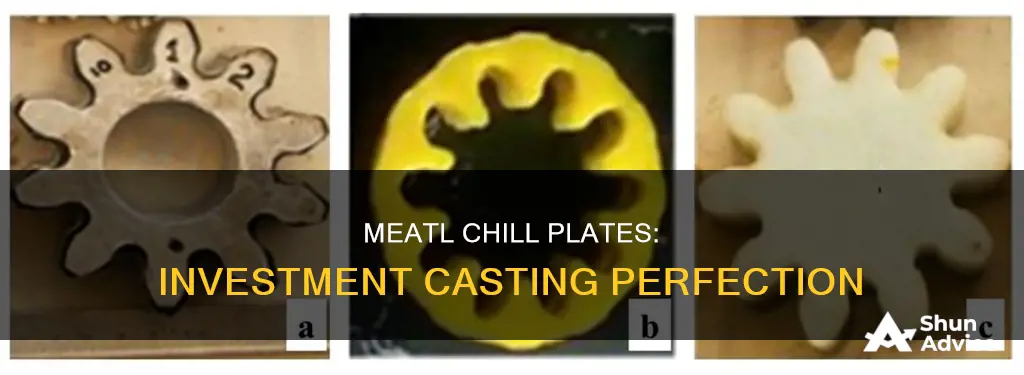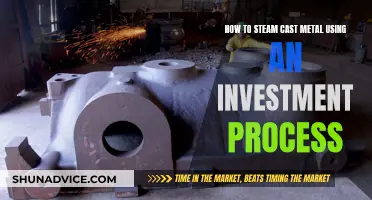
Investment casting, also known as the lost wax process, is a manufacturing technique used to create complex shapes with tight tolerances, thin walls, and superior surface finishes. It is commonly used in industries such as aerospace, defence, and automotive to produce components like turbine blades. Metal chill plates are an essential aspect of the investment casting process, playing a crucial role in ensuring the desired outcome. Chills are metal inserts or blocks strategically placed inside or on the surface of the mould cavity to promote directional solidification and uniform cooling of the casting. They help increase the heat extraction capacity of the mould, providing a steeper temperature gradient and reducing hot spots.
What You'll Learn

Metal chill plates are used to speed up the local cooling rate of the casting
Metal chill plates are an important component of the investment casting process, particularly when producing complex shapes and intricate parts. Investment casting, also known as lost-wax casting, involves creating a wax pattern of the desired shape, which is then coated with a ceramic shell. The wax is melted and removed, leaving a cavity into which molten metal is poured to create the final casting. Metal chill plates, or simply "chills", are used within this process to control the cooling and solidification of the molten metal, ensuring the production of high-quality castings.
Chills are metal inserts or blocks strategically placed inside the mould cavity or on its surface to promote directional solidification and uniform cooling. They are made of materials with high thermal conductivity, such as copper, iron, steel, bronze, aluminium, or graphite. The use of chills becomes essential when the geometry of the mould cavity prevents directional solidification from occurring naturally, which can lead to defects in the final casting.
There are two types of chills: internal and external. Internal chills are placed inside the mould cavity, and when the molten metal fills the cavity, part of the chill melts and becomes a part of the final casting. Therefore, internal chills must be made of the same material as the casting. External chills, on the other hand, are placed on the edge of the mould cavity, becoming part of the wall. These external chills can be made of various materials, such as steel, cast iron, copper, aluminium, or non-metallic materials like zircon sand or graphite, and they can be recycled and reused.
The placement of chills helps to increase the local cooling rate of the casting, particularly in thicker sections, by providing a steeper temperature gradient. This rapid cooling of thick sections eliminates hot spots and shrinkage defects. Additionally, chills can be used to control the solidification sequence of the casting, increase the feeding distance of the riser, and prevent cracks by eliminating local thermal stress. For castings made of alloys with a slow solidification rate, such as aluminium alloys, chills can reduce the formation of pinholes by accelerating the solidification process.
The use of metal chill plates in investment casting is a critical technique to ensure the production of high-quality, defect-free castings. By controlling the cooling and solidification process, chills help achieve uniform and consistent results, making them an essential tool in the investment casting process.
Business Cycle Investing: Strategies for Success
You may want to see also

They are placed inside the cavity and on the surface of the mould
Metal chill plates are placed inside the cavity and on the surface of the mould to promote directional solidification and uniform cooling of the casting. They are used to increase the heat-extraction capacity of the sand mould, providing a steeper temperature gradient.
There are two types of chill plates: internal and external. Internal chill plates are placed inside the mould cavity and eventually become part of the final casting. When the molten metal comes into contact with the solid chill plates, they start to melt, providing progressive directional solidification. As such, internal chill plates must be made of the same material as the casting. External chill plates, on the other hand, are placed on the surface of the mould and can be recycled and reused. They are usually made of materials with high heat capacity and thermal conductivity, such as steel, cast iron, copper, aluminium, graphite, or silicon carbide.
Chill plates are strategically placed to promote directional solidification when the geometry of the mould cavity prevents it from occurring naturally. They are particularly useful when the thickness of the casting is uneven, helping to reduce shrinkage and porosity defects in the final casting. Chill plates are also used to increase the feeding distance of a riser and to reduce the number of risers required.
Chase You Invest: A Comprehensive Guide to Getting Started
You may want to see also

They are used to obtain qualified castings
Metal chill plates are used in investment casting to promotesection end
> solidification and uniform cooling of the casting. They are placed inside the mould cavity or against the wall of the mould to increase the heat-extraction capacity of the sand mould, providing a steeper temperature gradient. This helps to prevent defects in the final casting, such as shrinkage and porosity.
Types ofsection start
> Chills
There are two types of chills used in investment casting: internal and external. Internal chills are placed inside the mould cavity and eventually become part of the final casting, so they should be made of the same material. External chills are placed on the surface of the mould pattern or against the wall of the mould cavity. They can be made of various metallic and non-metallic materials, such as steel, cast iron, copper, aluminium, graphite, or zircon sand.
Benefits of Usingsection start
> Metal Chill Plates in Investment Casting
Metal chill plates are used in investment casting to obtain qualified castings by improving the solidification process and reducing defects. Here are some of the specific benefits:
- Controlled Solidification and Cooling: Chills help promote directional solidification and uniform cooling of the casting. They increase the heat-extraction capacity of the sand mould, providing a steeper temperature gradient. This controlled cooling helps prevent defects and ensures the desired microstructure and properties in the casting.
- Elimination of Defects: By controlling the solidification process, chills help eliminate or reduce common defects such as shrinkage, porosity, and cracks. They can also prevent local thermal stress and hotspots, ensuring a more uniform and defect-free casting.
- Improved Feeding Distance: Chills can be used in conjunction with the gating and riser systems to increase the feeding distance of the riser. This enhances the efficiency of the feeding process and improves the quality of the casting.
- Reduced Number of Risers: The strategic placement of chills can reduce the number of risers required in the casting process. This simplifies the process and reduces the time and cost associated with creating additional risers.
- Enhanced Mechanical Properties: The use of chills helps refine the grain structure of the casting and improve its mechanical properties. This includes improving the hardness, ductility, and strength of the final product.
By utilising metal chill plates in investment casting, manufacturers can obtain qualified castings with improved quality and reduced defects. This technique is particularly useful when producing complex shapes or thin-walled applications, where traditional methods may struggle to achieve the desired results.
Emergency Cash: Best Places to Invest for Quick Access
You may want to see also

They are made of metallic or non-metallic materials
Chill plates are used in investment casting to speed up the local cooling rate of the casting and control the solidification sequence of the castings to obtain qualified castings. They are made of metallic or non-metallic materials.
Metallic chill plates are made from high carbon steel, medium carbon steel, cast iron, cast copper, cast aluminium, or the same materials as the desired castings. Non-metallic chill plates are made from zircon sand, graphite, carbon sand, chrome magnesia, chrome sand, magnesia, or other sand materials with higher densities, thermal conductivity, or thermal capacity. For example, chromite sand or zircon sand can be used when molding with silica sand.
The choice of material for the chill plate depends on the specific application and desired outcome. For instance, chromate sand or zircon sand with a good chilling effect should be used for large steel castings.
It is important to note that internal chills, which are placed inside the molding cavity, will eventually become part of the castings, so they should be made of the same material as the casting. On the other hand, external chills, which are placed on the surface of the pattern or core box, can be recycled and reused.
Maximizing Your Investments: Timing Your Cash Out
You may want to see also

They improve the mechanical properties of the casting
Metal chill plates are used in investment casting to improve the mechanical properties of the casting. Investment casting, also known as lost-wax casting, is a process used to create complex shapes with tight tolerances and thin walls. It involves creating a wax pattern of the desired shape, which is then coated with ceramic materials and dried. The wax is melted and removed, leaving a ceramic shell into which You may want to see also Chill plates are used to promote solidification and uniform cooling in specific parts of a metal casting mould. They are placed either inside the mould cavity (internal chills) or on the surface of the mould (external chills). Internal chills are pieces of metal placed inside the mould cavity. When the cavity is filled, the internal chills melt and become part of the final casting. Therefore, they must be made of the same material as the casting. External chills are placed on the edge of the mould cavity, becoming part of the wall of the cavity. They are made of materials with high heat capacity and thermal conductivity, such as steel, cast iron, copper, aluminium, graphite, or silicon carbide. External chills can be recycled and reused. Chill plates help to increase the feeding distance of a riser, reduce the number of risers required, and prevent shrinkage and porosity defects in the final casting. They also improve the mechanical properties of castings by refining the grain structure.Warren Buffet's Strategy for Investing Berkshire's Cash Reserves
Frequently asked questions







